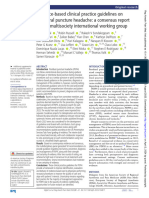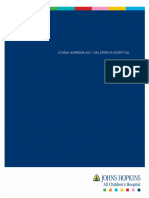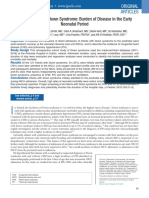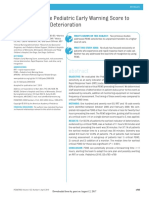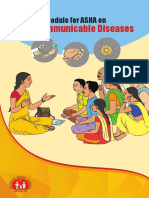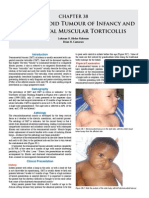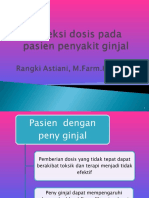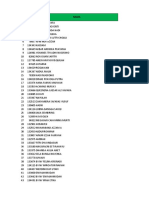A187 2 Full
A187 2 Full
Uploaded by
Danielle FeioCopyright:
Available Formats
A187 2 Full
A187 2 Full
Uploaded by
Danielle FeioOriginal Title
Copyright
Available Formats
Share this document
Did you find this document useful?
Is this content inappropriate?
Copyright:
Available Formats
A187 2 Full
A187 2 Full
Uploaded by
Danielle FeioCopyright:
Available Formats
Abstracts
Arch Dis Child: first published as 10.1136/archdischild-2022-rcpch.300 on 17 August 2022. Downloaded from http://adc.bmj.com/ on September 13, 2023 at UNICEUMA - Universidade
their choice of agent on findings from neonatal 1226 PARENTAL EXPERIENCE INTERVIEWS: PART OF A
echocardiography. DIRECT NICU TO PCCU TRANSFER SERVICE
IMPROVEMENT PROJECT
Shil Patel, Catarina Silvestre, Phoebe Kigozi. Nottingham University Hospitals NHS Trust
1203 LUNG ULTRASOUND COULD BE USED AS A SCREENING 10.1136/archdischild-2022-rcpch.300
FOR HEMODYNAMICALLY SIGNIFICANT PATENT
DUCTUS ARTERIOSUS (HPDA) – PROSPECTIVE STUDY Aims As part of a service improvement project, we aimed to
ascertain parental experiences when transitioning between the
1
Amelie Cyr, 2Prosanta Mondal, 1Veronica Samedi, 1Sibasis Daspal. 1Royal University Neonatal Intensive Care Unit (NICU) and the Paediatric Crit-
Hospital; 2University of Saskatchewan, Saskatoon ical Care Unit (PCCU).
10.1136/archdischild-2022-rcpch.299
Methods In this study, parents of infants hospitalised at the
Nottingham University Hospitals (NUH) tertiary NICU and
Aims Determining whether a PDA is hemodynamically signifi- directly transferred to PCCU were enrolled.
cant or not (non-hsPDA) is clinically relevant to evaluate the Parents were invited for an interview by a family care team
risk of associated morbidities and to determine subsequent administrator who also plays a key role in the NICU parental
management courses such as the need for intervention. A support group.
known consequence of hsPDA is pulmonary edema. Parents who agreed to an interview were then contacted at
The aim of the study is to evaluate whether the assessment their convenience and verbally consented by Dr Shil Patel.
of pulmonary edema by lung ultrasound is a reliable sono- The interviews were performed using a semi-structured for-
graphic indicator of hsPDA. Lung ultrasound could then be an mat to establish the background summary of their case, infor-
accessible bedside tool used to evaluate if a PDA is hemody- mation received about the transfer and opinions on some
namically significant and to assist with decision-making regard- suggested interventions. Open questions were used to elicit
ing its management along with other clinical and their personal experiences.
echocardiographic indicators. The interviews were not recorded but indirect quotations
Methods We conducted a prospective study of 20 infants in were recorded with key themes noted.
Ceuma. Protected by copyright.
the Neonatal Intensive Care Unit at the Jim Pattison Child- Results Four parent interviews were undertaken, representing
ren’s Hospital, Canada, between July 2019 to October 2020. 10% of NICU to PCCU transfers at NUH over the last 10
Inclusion criteria were very preterm infants (gestational age years. Two were ex-preterm current PCCU patients, with one
less than 32 weeks) with low birth weight (less than 2500 awaiting a tracheostomy and one weaning tracheostomy venti-
grams) who had an echocardiogram and a bedside lung ultra- lation. Two were children who had surgical airways and were
sound assessment within their first two weeks of life. two years post discharge.
The infants were divided into two groups based on their 6 key themes emerged including clarity/amount of informa-
echocardiogram findings: infants with a non-hsPDA (no PDA tion received, differences in care approaches, expectations
or non-hsPDA) and infants with a hsPDA. Differences in clini- around parental involvement and outcomes, pre-transfer tours,
cal characteristics, echocardiogram findings, and lung ultra- available support for parents and finally the perceptions
sound scores were evaluated. around transfer. Figure 1.
A bedside lung ultrasound was done on the same day as Key quotes outlined in table 1.
the echocardiogram to assess for the presence of pulmonary Parents wanted more information, seeking information else-
edema. Lung ultrasound scoring was used to evaluate oxygena- where, and felt that it was ‘empowering when more informa-
tion needs. tion is given’.
Results The echocardiographic and lung ultrasound scores of They noticed the ‘culture’ difference between the two units,
infants included in this study are summarized in table 1. Six even minor aspects like the number of bedside toys. They
patients (6/20) did not have a PDA (2/6) or had a non- also struggled to understand why the approach to management
HsPDA (4/6) while 14 patients (14/20) had an HsPDA based was so different ‘when the child is the same’.
on echocardiogram findings. The expectation of the plan prior to transfer was also a
LUS score was significantly higher (10.6) in the HsPDA key talking point, with all parents having the expectation
group compared to the non-HsPDA group ( 6.0), and these of going to PCCU to wean respiratory support and go
indices correlated with echocardiographic parameters. home.
Perception of the transfer was also key as many felt the
day of transfer was rushed and due to ‘bed pressure’.
Abstract 1203 Table 1 The parents who received tours before transfer greatly
appreciated them. One stating that they still remember the
doctor and nurse who conducted them.
Parents overall felt more supported on NICU. They found
it difficult to relate to other parents on PCCU and got much
Conclusion • This study demonstrates that LUS scoring can be of their support outside of the units, through social media
used as a sonographic indicator of hsPDA.However, given sig- and groups.
nificant limitations – further studies with a larger population
size are required.
Arch Dis Child 2022;107(Suppl 2):A1–A537 A187
Abstracts
Arch Dis Child: first published as 10.1136/archdischild-2022-rcpch.300 on 17 August 2022. Downloaded from http://adc.bmj.com/ on September 13, 2023 at UNICEUMA - Universidade
Documentation should include indication for insertion, site,
number of attempts, batch number, expiry date, length of use
& reason for removal.
Review any complications after insertion e.g., infection,
thrombosis, extravasation.
Methods A total of 33 cases identified over 6 months period.
Review of cases included gestational age, birth weight and
indication for long line insertion. Other areas reviewed
included, grade of clinician performing procedure, type of line
inserted, grade of assistant, x-ray confirmation of line position
and any complications following the procedure.
Type of line inserted included Premicath, UVC/UAC, Vygon,
Temena
Results In most cases, infant’s weight was < 2kg (28/33 cases)
and gestational age was equal to or less than 32 weeks‘ gesta-
tion (23/33 cases) i.e., long line insertion was required more
for the low birth weight or small gestational age infants.
TPN was the main indication for long line insertion (in 27/
33 cases) with other indications including IV fluids, medica-
tions, monitoring (figure 1).
Abstract 1226 Figure 1 Majority of lines were inserted by middle grade paediatri-
cian (21/33 cases). Check lists were completed in 16/33 cases.
Documentation in the case notes was recorded in 31 cases.
Type of line inserted; 12 cases had Premicath, in 8 cases
Abstract 1226 Table 1
Vygon was used, 9 had an umbilical line, Temena was used in
one case (figure 2). In 3 cases, not clearly documented. All
Ceuma. Protected by copyright.
cases had an x-ray to confirm long line placement.
Conclusion In a limited number of parent interviews, we
observed that families struggle with transition periods, whether
that is admission, step downs or transfers.
Children transferred directly from NICU to PCCU make
up a very low number of patients. However, they occupy dis-
proportionate resources. They frequently go on to require fur-
ther support in the community. The parents need to be
supported to look after their children who have complex
needs in hospital and perhaps beyond.
These results are informing our local improvement plan for Abstract 1228 Figure 1 Indications for long or central line insertion
the transition of care pathways between NICU and PCCU;
and should be considered by other units with similar patients.
1228 A REVIEW OF LONG LINE INSERTION AT A LEVEL TWO
NICU IN A DGH, ENGLAND, UK: FOLLOWING BEST
PRACTICE IN PERFORMING PROCEDURE, AFTERCARE
AND DOCUMENTATION
1
Khairy Gad, 2Maged Amin. 1Consultant Paediatrician, Health and Social Care, UK;
2
Paediatrician, UK
10.1136/archdischild-2022-rcpch.301
Aims Long line insertion is aseptic procedure.
A checklist should be completed after the Long Line is Abstract 1228 Figure 2 Type of long or central line
inserted.
A188 Arch Dis Child 2022;107(Suppl 2):A1–A537
You might also like
- Spontaneous Closure of Patent Ductus Arteriosus in Infants 1500 GDocument8 pagesSpontaneous Closure of Patent Ductus Arteriosus in Infants 1500 GBrave KazmiNo ratings yet
- RCP y Resultados A Corto Plazo en Prematuros. JPedDocument8 pagesRCP y Resultados A Corto Plazo en Prematuros. JPedSheila Patricia Castro ErazoNo ratings yet
- A Clinical Prediction Rule For The Severity ofDocument9 pagesA Clinical Prediction Rule For The Severity ofDara Dasawulansari SyamsuriNo ratings yet
- Art Borrador 2Document10 pagesArt Borrador 2Laura jasbleidy Gutiérrez agudeloNo ratings yet
- Fatal and Near-Fatal Asthma in Children: The Critical Care PerspectiveDocument11 pagesFatal and Near-Fatal Asthma in Children: The Critical Care PerspectiveElvis Rodríguez PalmaNo ratings yet
- 114 How Parents To Technology Dependent Children Experience The Transition From A Hospital Stay To Professional Home Care NursingDocument1 page114 How Parents To Technology Dependent Children Experience The Transition From A Hospital Stay To Professional Home Care NursingDaniella AwurumibeNo ratings yet
- Cefalea PospuncionDocument31 pagesCefalea Pospuncionmanolo.mendozavNo ratings yet
- Pulse Oximetry and Auscultation For Congenital Heart Disease DetectionDocument11 pagesPulse Oximetry and Auscultation For Congenital Heart Disease DetectionAzkiaNo ratings yet
- Conlon 2019 JJJJJDocument19 pagesConlon 2019 JJJJJDr.gendjutNo ratings yet
- PDAPathway-11 22 2023Document25 pagesPDAPathway-11 22 2023jhudd23No ratings yet
- WRIGHT 2016 - Continuous Positive Airway Pressure To Prevent Neonatal Lung InjuryDocument10 pagesWRIGHT 2016 - Continuous Positive Airway Pressure To Prevent Neonatal Lung InjuryRafael JustinoNo ratings yet
- Children Less Than 2 With Down Syndrome and SufferDocument1 pageChildren Less Than 2 With Down Syndrome and Sufferhqsfc4gmrnNo ratings yet
- Peds 2020007369Document11 pagesPeds 2020007369lb_elianaNo ratings yet
- Smjernice Postpunkcijske GlavoboljeDocument48 pagesSmjernice Postpunkcijske GlavoboljecatipovickNo ratings yet
- Congenital Diaphragmatic Hernia Defect Size and Infant Morbidity at DischargeDocument10 pagesCongenital Diaphragmatic Hernia Defect Size and Infant Morbidity at DischargeResidencia Cirugía Pediátrica San JustoNo ratings yet
- HIV PXDocument8 pagesHIV PXCarol VizcainoNo ratings yet
- 4_5895755809706478550Document30 pages4_5895755809706478550mokasysNo ratings yet
- Retrospective Analysis of Inpatient Polysomnogram Characteristics in Infants With Broncopulmonary DisplasiaDocument30 pagesRetrospective Analysis of Inpatient Polysomnogram Characteristics in Infants With Broncopulmonary DisplasiaJHONATAN MATA ARANDANo ratings yet
- Neonatal Acute Kidney InjuryDocument13 pagesNeonatal Acute Kidney InjuryulfiNo ratings yet
- Alternatives To Surgery in Children WithDocument8 pagesAlternatives To Surgery in Children WithvenancioNo ratings yet
- Pediatric Hydrocephalus: Systematic Literature Review and Evidence-Based Guidelines. Part 1: Introduction and MethodologyDocument5 pagesPediatric Hydrocephalus: Systematic Literature Review and Evidence-Based Guidelines. Part 1: Introduction and MethodologyagusNo ratings yet
- Hpeds.2022 006633 2Document8 pagesHpeds.2022 006633 2LEVITRON7No ratings yet
- Suresh 2015Document6 pagesSuresh 2015ade_liaNo ratings yet
- Neonatal Respiratory System Updates 2020Document824 pagesNeonatal Respiratory System Updates 2020link_wolfloboNo ratings yet
- Management Outcomes of Hydrocephalus Among Under Five Children in A Tertiary Hospital in Gombe North Eastern NigeriaDocument4 pagesManagement Outcomes of Hydrocephalus Among Under Five Children in A Tertiary Hospital in Gombe North Eastern NigeriaInternational Journal of Innovative Science and Research TechnologyNo ratings yet
- HydrocephalusDocument9 pagesHydrocephalusDeby AnditaNo ratings yet
- Commercial Premixed Parenteral Nutrition and Its Potential Role in PediatricsDocument5 pagesCommercial Premixed Parenteral Nutrition and Its Potential Role in PediatricsLilik FitrianaNo ratings yet
- Enhanced Perioperative Management of Children With Autism - A Pilot StudyDocument10 pagesEnhanced Perioperative Management of Children With Autism - A Pilot Studydra.bravodanielaNo ratings yet
- Bass An 2006Document8 pagesBass An 2006Arjun .MNo ratings yet
- Journal of Pediatric SurgeryDocument4 pagesJournal of Pediatric SurgeryGrace Juniaty GozaliNo ratings yet
- BBLR 2Document8 pagesBBLR 2Radhiatul AdillahNo ratings yet
- Analysis of Incidence and Genetic Predisposition of Preauricular SinusDocument3 pagesAnalysis of Incidence and Genetic Predisposition of Preauricular Sinusanitaabreu123No ratings yet
- Respcare 05961 FullDocument6 pagesRespcare 05961 FullWuppuluri Jayanth Kumar SharmaNo ratings yet
- Martin 2017Document6 pagesMartin 2017Peregrine Albertus Ricco AzaliNo ratings yet
- Classification of Pediatric Urinary Tract Dilation: The New LanguageDocument8 pagesClassification of Pediatric Urinary Tract Dilation: The New LanguageGabriel ZambranoNo ratings yet
- Umbilical Cord MilkingDocument12 pagesUmbilical Cord MilkingTika WulandariNo ratings yet
- Epidemiology of Neonatal Acute Respiratory.6Document12 pagesEpidemiology of Neonatal Acute Respiratory.6Victor EzraNo ratings yet
- Art TaaDocument7 pagesArt TaaCristinaNo ratings yet
- REVJURDocument9 pagesREVJURTiyas MasaidNo ratings yet
- A Randomized Placebo-Controlled Pilot Trial of Early Targeted Non-Steroidal AntiInflammatory Drugs in Preterm Infants With A Patent Ductus ArteriosusDocument22 pagesA Randomized Placebo-Controlled Pilot Trial of Early Targeted Non-Steroidal AntiInflammatory Drugs in Preterm Infants With A Patent Ductus ArteriosusGlydenne Glaire Poncardas GayamNo ratings yet
- Bronchopulmonary Dysplasia Executive Summary of A 2018Document18 pagesBronchopulmonary Dysplasia Executive Summary of A 2018Raul VillacresNo ratings yet
- Severity Scoring Systems: Are They Internally Valid, Reliable and Predictive of Oxygen Use in Children With Acute Bronchiolitis?Document7 pagesSeverity Scoring Systems: Are They Internally Valid, Reliable and Predictive of Oxygen Use in Children With Acute Bronchiolitis?Ivan VeriswanNo ratings yet
- Clinical Consensus Statement Pediatric Chronic RhinosinusitisDocument12 pagesClinical Consensus Statement Pediatric Chronic RhinosinusitisThomasMáximoMancinelliRinaldoNo ratings yet
- Pi Is 1875957219305510Document10 pagesPi Is 1875957219305510madimadi11No ratings yet
- Tto ProtocoloizadoDocument13 pagesTto Protocoloizadolb_elianaNo ratings yet
- Paediatric HydrocephalusDocument81 pagesPaediatric HydrocephalussrisaravananNo ratings yet
- 2018 - Plagiocephaly and Developmental Delay A Systematic ReviewDocument12 pages2018 - Plagiocephaly and Developmental Delay A Systematic ReviewStanley YuNo ratings yet
- PewsDocument9 pagesPewsMahfiraRamadhania100% (1)
- Hospitalizations For Ambulatory Care-Sensitive Conditions Among Children With Chronic and Complex DiseasesDocument7 pagesHospitalizations For Ambulatory Care-Sensitive Conditions Among Children With Chronic and Complex DiseasesHasriana BudimanNo ratings yet
- April 2021 - Pediatric Emergency CareDocument128 pagesApril 2021 - Pediatric Emergency CareEdison Junior Juarez Larico100% (3)
- A Clinical Pathway To Standardize Care of Children With Delirium in Pediatric Inpatient Settings-2019Document10 pagesA Clinical Pathway To Standardize Care of Children With Delirium in Pediatric Inpatient Settings-2019Juan ParedesNo ratings yet
- Research ArticleDocument9 pagesResearch ArticleAnonymous zNUqQaNo ratings yet
- 2023 - Echocardiographic Parameters Predicting Spontaneous Closure of Ductus Arteriosus in Preterm InfantsDocument7 pages2023 - Echocardiographic Parameters Predicting Spontaneous Closure of Ductus Arteriosus in Preterm InfantsFajar Khalis AnandaNo ratings yet
- Medical Decision Making Among Adolescents With Neonatal Brachial Plexus Palsy and Their Families: A Qualitative StudyDocument8 pagesMedical Decision Making Among Adolescents With Neonatal Brachial Plexus Palsy and Their Families: A Qualitative StudyPaoloLansangNo ratings yet
- Followup Care of Highrisk Infants 2004Document23 pagesFollowup Care of Highrisk Infants 2004abhishek4aiimsNo ratings yet
- BBLRDocument11 pagesBBLRazzahra PutriNo ratings yet
- Sem Fetal&Neonatal Med. 08.2018 (PDA)Document77 pagesSem Fetal&Neonatal Med. 08.2018 (PDA)Abraham VallejosNo ratings yet
- HHS Public Access: Kangaroo Care For Hospitalized Infants With Congenital Heart DiseaseDocument12 pagesHHS Public Access: Kangaroo Care For Hospitalized Infants With Congenital Heart DiseaseSri MawarniNo ratings yet
- ICCS Standardization Report On Urodynamic StudiesDocument8 pagesICCS Standardization Report On Urodynamic StudiesAndy WijayaNo ratings yet
- Advances in Critical Care Pediatric Nephrology: Point of Care Ultrasound and DiagnosticsFrom EverandAdvances in Critical Care Pediatric Nephrology: Point of Care Ultrasound and DiagnosticsSidharth Kumar SethiNo ratings yet
- Asha NCD Module - 270117Document72 pagesAsha NCD Module - 270117akshay dhootNo ratings yet
- The Ivy Bleeding Time and The Saga of Andrew C. IvyDocument2 pagesThe Ivy Bleeding Time and The Saga of Andrew C. IvyErick RiveraNo ratings yet
- Jurnal Porlanis KualiDocument10 pagesJurnal Porlanis KualiRegina HamzahNo ratings yet
- Drug Information Bulletin 52 05Document8 pagesDrug Information Bulletin 52 05amritaryaaligarghNo ratings yet
- Thyroid Disease in PregnancyDocument70 pagesThyroid Disease in PregnancyRajeev Sood100% (1)
- Clinical Outcome of Proximal Tibia Plates in ExtraDocument5 pagesClinical Outcome of Proximal Tibia Plates in ExtraSouha KhmiriNo ratings yet
- Med Math Study GuideDocument13 pagesMed Math Study GuideHaris A100% (1)
- Help Pedsurgeryafrica38Document6 pagesHelp Pedsurgeryafrica38madalinamihailescuNo ratings yet
- Phthalates Exposure As Environmental Risk Factor For Type 2 Diabetes MellitusDocument9 pagesPhthalates Exposure As Environmental Risk Factor For Type 2 Diabetes MellitusIJPHSNo ratings yet
- GAD Treatment OptionsDocument3 pagesGAD Treatment OptionsRosaNo ratings yet
- Sunita NepalDocument5 pagesSunita NepalPrajay NepalNo ratings yet
- Medical Journal of Australia - 2024 - Shukla - Respecting The Role of General PractitionersDocument1 pageMedical Journal of Australia - 2024 - Shukla - Respecting The Role of General PractitionersrumaysabarNo ratings yet
- 24 - Arterial Access - Umbilical Artery CatheterizationDocument10 pages24 - Arterial Access - Umbilical Artery CatheterizationJesica DiazNo ratings yet
- 3 4 PERTEMUAN 3 - 4 Far RangkiDocument35 pages3 4 PERTEMUAN 3 - 4 Far RangkiNoerhayatea SibaraniNo ratings yet
- Daftar Pustaka YyyahahajshDocument7 pagesDaftar Pustaka YyyahahajshDiki NugrahaNo ratings yet
- Hinkle PPT CH 17Document25 pagesHinkle PPT CH 17maniz442100% (2)
- Research Methods in Biopsychology: Lecture Notes Based On Pinel, Chapter 5Document28 pagesResearch Methods in Biopsychology: Lecture Notes Based On Pinel, Chapter 5Diwakar RajputNo ratings yet
- Unit 3 Obt356Document21 pagesUnit 3 Obt356wv3946601No ratings yet
- SeminarskiDocument17 pagesSeminarskiKadric Nagla UtokaNo ratings yet
- MetronidazoleDocument1 pageMetronidazoleLourdes SiquiSalNo ratings yet
- TRAb MaglumiDocument6 pagesTRAb MaglumiLaboratoire Dr Mansouri Reghaia AlgerNo ratings yet
- Microbial Proteomics and Their Importance in Medical MicrobiologyDocument12 pagesMicrobial Proteomics and Their Importance in Medical MicrobiologyRoxanna LaysecaNo ratings yet
- Hgriffithresum 2023Document2 pagesHgriffithresum 2023api-702639694No ratings yet
- Senarai Semak AmbulanceDocument2 pagesSenarai Semak Ambulancekenny nanaNo ratings yet
- RANAP 2020 KomputerDocument432 pagesRANAP 2020 KomputerfokaliwatesNo ratings yet
- Assessing N Documenting Fluid BalanceDocument9 pagesAssessing N Documenting Fluid BalanceWinda Ayu Sholikhah0% (1)
- Skill Simple SchizophreniaDocument11 pagesSkill Simple SchizophreniasaidahrahmatNo ratings yet
- Lecture 2 QuizDocument2 pagesLecture 2 QuizNhư Ý NguyễnNo ratings yet
- DAFTAR OBAT ApotekDocument3 pagesDAFTAR OBAT ApotekWahyu ade putraNo ratings yet
- Full Download Comprehensive Dermatologic Drug Therapy 4th Edition Edition Stephen Wolverton PDFDocument64 pagesFull Download Comprehensive Dermatologic Drug Therapy 4th Edition Edition Stephen Wolverton PDFcalulohleza100% (1)






